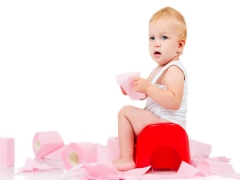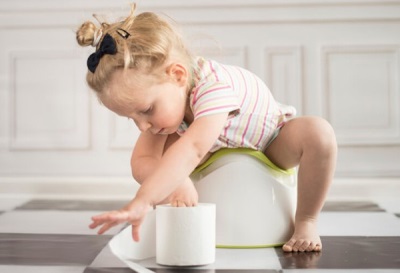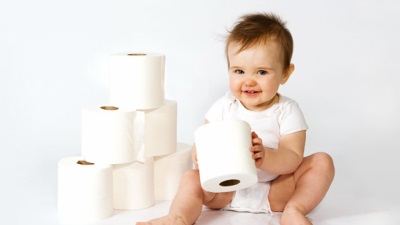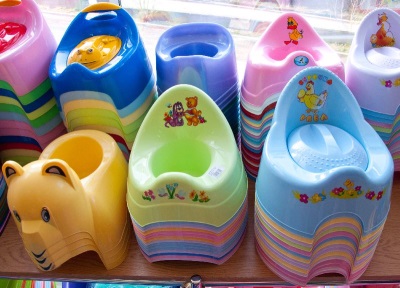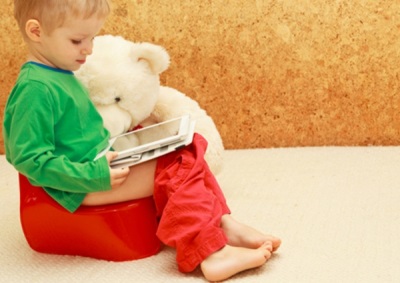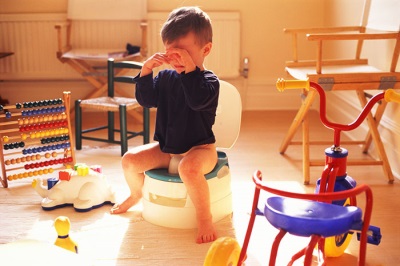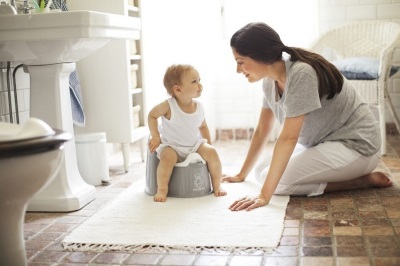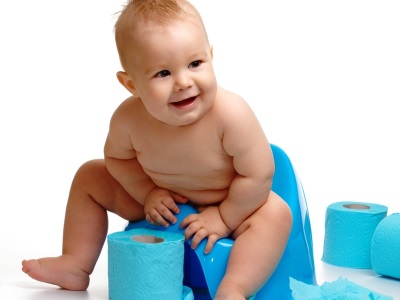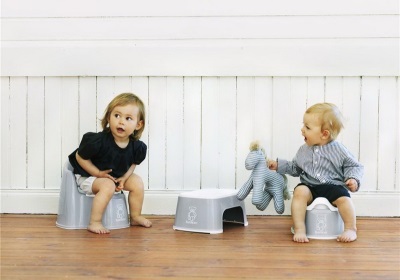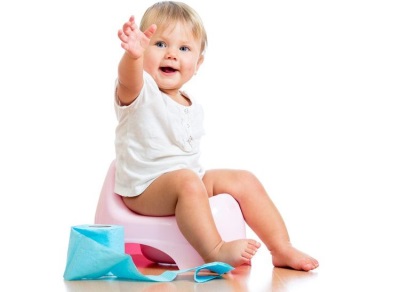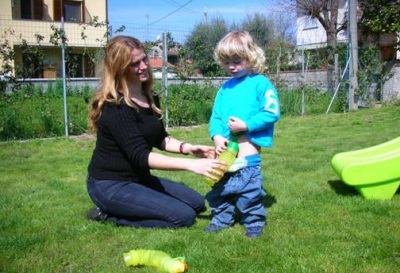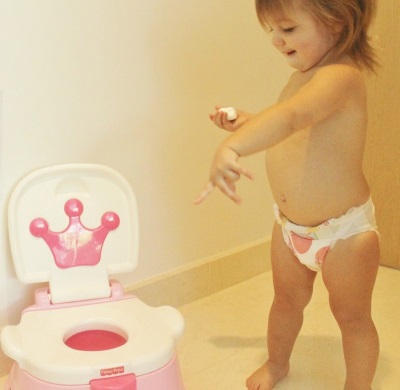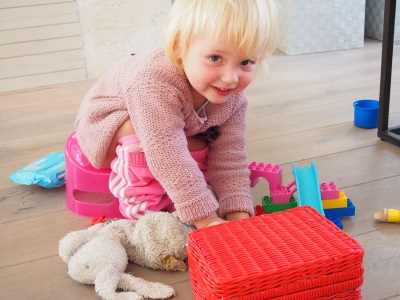How to teach a child to the pot?
In the first years of life, children learn many different skills, among which there is also the management of their physiological needs. The maturing child quickly takes possession of the pot, if he is ready for schooling, and the parents act correctly.
What age to teach a child to the pot: expert advice
In connection with the proliferation of disposable diapers, many parents were able to postpone the question of dating a baby with a pot for a later time. And although there are a number of adherents of early planting, most parents consider the recommendations of pediatricians in relation to the beginning of the development of pot cases. These recommendations are based on the physiological readiness of the child.
Modern doctors advise to wait for the age at which children can consciously control the excretory function. This age is considered 18-24 months.
Of course, some children can master pot science before one and a half years, and someone cannot control urination and over the age of two years, but it is during this time period that most babies are able to quickly master the pot, provided they are ready for this skill.
Read more about the opinions of experts in the article "Komarovsky: how to teach a child to the pot".
Readiness criteria
Parents can assess how ready the child’s body is for schooling according to the following criteria:
- Episodes of urination and defecation of a child occur at a certain steady interval.
- The baby is in a clean dry diaper for a half to two hours.
- Scarce knows how different wardrobe items and body parts are called.
- The child understands what the words "poop" and "pee" mean.
- If the baby's diaper has become wet or dirty, the baby shows its displeasure.
- Scarce learns or has already learned how to put on pants and underwear, as well as take them off.
- The kid can show with a gesture, sounds or words his desire to go to the toilet.

Choosing a pot is an important step on the road to schooling.
The current range of pots in children's stores is striking in its diversity and causes some difficulties in purchasing a suitable product. You can see pots of different colors and with some additional functions, for example, in the form of a toy or with music.
All experts are unanimous that the pot should be selected taking into account comfort for the child. This means that the baby should be comfortable on it. At the same time pediatricians do not advise buying musical pots and toys as toys, as they oppose the formation of an association with the game.
The best choice would be a regular pot, with the purchase of which follow these recommendations:
- Pick a pot in accordance with the age and height of the child. The accessory should not be too low or too high.
- Plastic models are preferable because they are not cold.
- Make sure the accessory is fairly stable.
- It is desirable that the pot had a small back. At the same time, he should not resemble a chair, so that the child does not confuse this hygiene item with an ordinary chair.
- Let the child sit on the new pot, and you look at the location of the back of the baby in relation to the thigh line, as well as the location of the hips in relation to the lower legs. It is important that right angles form everywhere, then the child’s efforts during use of the pot will be directed in the right direction.
- For girls, buy a round pot, and for boys, an oval-shaped piece of hygiene is preferable. In addition, small men should look for products that have a small ledge in front.
- A good choice would be a pot with a removable seat, which in the future can be used as a lining on a regular toilet.
Effective methods and stages of learning
Having decided to teach a child to go to the pot, please be patient and give the crumbs enough attention. The first acquaintance with a new subject of hygiene should not frighten the baby. Show the pot to the crumbs and demonstrate its purpose with a plush toy or doll.
If the child has always been in diapers, it is recommended to remove it. This is important because it helps the child to get acquainted with his own body, as well as to note the link between the urge to use the toilet and its result.
To make the process faster and easier, you should:
- Act systematically.
- Keep the pot in a visible place.
- Closely monitor the child's behavior.
- Wear a minimum of clothes to the baby.
- Always land after eating and after waking up.
- Affectionately praise, emphasizing the fact that dry and clean panties - this is good.
In the process of learning should not:
- Scold the child and punish him.
- Too vigorously rejoice and reward the baby for every successful attempt.
- Turn on the tap so that the sound of the babbling water “helps” the child.
- Seated on the pot by force.
- Plant a child if he has already learned to do it on his own.
- Start training during illness.
- Equal to the children of neighbors and relatives, because each child develops individually.
How to teach a pot for 7 days?
There is a simple seven-day method of potty training for children over 1.5 years of age who understand the words of their parents and are able to take off their panties.
Many mothers tried it out, confirming the effectiveness of this approach:
- On the first day, immediately after waking up in the morning, take the diapers off the child, put on panties on the baby, emphasizing that all adults go to them, and then plant the baby on the potty. We must try to crumb sat on it for ten minutes. If such an attempt is not effective, plant a child every 15 minutes. If the result was unsuccessful, do not swear, and change the baby and continue to often offer the pot.
- On the second day, do not take your kid with any active activities and walks, but pay attention to consolidating the skill of positive communication with the pot.
- On the third day, gathering with a baby for a walk, offer to sit in a pot, and during the walk itself, ask more often if the child wants to go to the toilet. You can grab the pot on the street or go with the baby in the bushes.
- By the fourth day, both the parents and the child already know roughly when to sit on the pot. It is necessary to remind the child about him more often, and to celebrate every success with praise.
In 3 days
As you know, the “road” to the pot in most of the children is long, but there are situations when you have to hurry the baby, for example, before traveling or starting kindergarten.For such situations, developed a rapid technique that requires only a few days. Note that this method allows you to teach a child to be without a diaper only in the period of wakefulness, since the complete rejection of the diaper requires much more time.
Also, for the success of express training, it is important that the child be familiar with the pot in advance (about 2 weeks) and periodically hear from the parents about his appointment and upcoming changes, refusal of diapers and new beautiful linen. In addition, this technique is suitable only in the case of the physiological readiness of the child.
- On the first day, the baby is taken off the diaper as soon as the baby woke up in the morning. Baby will run all day at home without clothes or in shorts, and adults should always be around, keeping the pot ready. Noticing that the child began to write or is going to poop, you need to immediately sit the baby on the pot. This will help the child to establish the relationship between such actions and planting. We note all “hits” with praise, but we do not notice any misfires. Your goal is to instill a positive attitude towards the pot and an understanding of the necessity of planting on it. At bedtime, the child is wearing a diaper.
- On the second day, plan one walk without a diaper. Going to the street should immediately after the baby successfully went to the pot. Be sure to bring clean clothes. By all means we praise the child for all the successful "work".
- On the third day we go out without a diaper for a walk twice. At the same time we plant a crumb on a potty before each walk and immediately, as we returned from the street.
Is potty training for girls different from girls?
Many mothers of boys think about how to immediately teach their son to use the pot while standing, but experts recommend to sit the boys on the pot, as well as girls. This is important for the child to understand the purpose of the pot and to more successfully master this skill. So that the crumb is not confused, at first it is advised to offer the child to do all the things sitting.
How to secure furniture?
Since during the development of the pot "accidents" happen quite often, on the sofas and chairs you can lay extra bedspreads, folded towels or disposable diapers. It is also recommended to remove the carpet from the floor, since it is more convenient to wipe the puddles from a hard smooth surface.
How to teach a child to ask for a pot?
Carefully observe the child's behavior and as soon as they noticed that the pussy wanted to go to the toilet, immediately plant it in the pot. You can understand the desire of the child according to his behavior, for example, the child becomes silent or hides, begins to groan and blush. Having done his own business in a potty and having received praise and a smile from the mother, the child will quickly connect his desires with the result, and will soon be asking himself.
Refusing a diaper on the street
Once the skill of using the pot at home has become sustainable in the child, it is necessary to move on to the next step - to teach the baby to stay without diapers during the walk. This is preferably done during the warm season.
Follow these tips:
- Suggest the crumbs to sit on the pot before a walk.
- You can take the pot with you to the street if the child is totally against walking in the bushes.
- Put spare pants, pants and socks in your bag, and even better - a few such sets.
- If an “accident” occurred on the street, kindly explain to the child that his pants are wet and have to be changed, and next time it's better to “water the grass” or go to the pot on time.
- When the crumb during a walk asks for a pot, be sure to praise and hug.
- After returning home, again offer the child to go to the pot.
Soon the child will learn to endure during the walk and you will be able to leave the pot and spare clothes at home.
We cancel night diapers
Over time, when the child learned to use the pot for its intended purpose in the daytime, the baby begins to wake up at night because of the urge to use the toilet. This is the best time to give up a disposable diaper.
If the baby did not sleep in the diaper before, then he begins to get up at night because of the need much earlier than the children who slept in the pampers. For most babies, urination control that appeared by 2 years of age allows them to sleep at night without going to the toilet. But, while the baby wakes up at night and pees in the diaper, it is impractical to refuse it. Parents should only be offered daily to go to the pot before going to bed.
Possible causes of failures
At the stage of mastering a pot by a child, various difficulties may arise, for example:
- Severe discomfort due to cutting teeth can interfere with the crumbs in time to react to their desire to go to the pot. The same reason can cause "accidents" during any illness of the child.
- The baby can be very keen on the game and not notice the bladder overflow.
- Due to developmental crises, a peasant may protest against any actions by an adult.
- The child may begin to be afraid of the pot, if the parents took up the task of mastering this subject of hygiene too actively, scold the child for failures and do not pay attention to the unpreparedness for this skill.
When may need re-training?
The toddler, who has successfully mastered pottery science, may suddenly stop going to the toilet for several reasons:
- Due to external stress factors, for example, after moving, the birth of a little brother or sister, admission to the garden, visiting a new group in the garden and similar reasons.
- Because of the crisis of three years. At this age, children often do everything in defiance, showing that they are already adults and independent.
- Due to family problems, for example, divorce parents or their frequent quarrels.
- Due to illness or cutting teeth.
In any case, it is important to first find out the possible cause and influence it, and then proceed to re-patiently teach the child to “communicate” with the pot.
When to contact specialists?
Identifying different urological problems in young children is not easy, but if parents have noted too frequent urination episodes during the daytime, lack of urinary control during the day for a child over 3 years old, and also maintaining involuntary urination at night for a child over 5 years old, you should consult a specialist.
First, you should consult with the pediatrician and pass general tests, and then show the baby to the urologist. This specialist will examine the child and prescribe the necessary examinations, and if they do not find any urological pathologies, then the child will be referred to a neuropathologist.
For information on how to teach a child to the pot, see the transfer of Dr. Komarovsky.
